Oliver
Pulled from the streets of rural Mississippi with his sister, Oliver was one of thousands of animals helped through the ASPCA’s Animal Relocation Program. He traveled to New York as part of a milestone 100,000th transport and was quickly adopted. Now living in Miami, he’s thriving with a loving family and a life filled with beach days, toys and long walks.
Maeve
Maeve came to the ASPCA with severe burn wounds on her back, chest and legs. She was fearful and in pain but thanks to expert medical care, gentle fostering and lots of patience, she began to heal. Her resilience and spirit shine in her new home where she is now cherished, protected and as her family says, “the queen of the castle.”.
Read more of Maeve’s story
When Alex M. went for a jog one day, he came across a group of ASPCA dogs on a walk and was inspired to check our website to see who might be available for adoption. Little did he know, this thought would soon change the life of one sweet little dog who was in need of a second chance.
While browsing online, Alex and his wife Heather came across Maeve, a 3-year-old Chihuahua who was wearing a costume dinosaur hood in one of her photos.
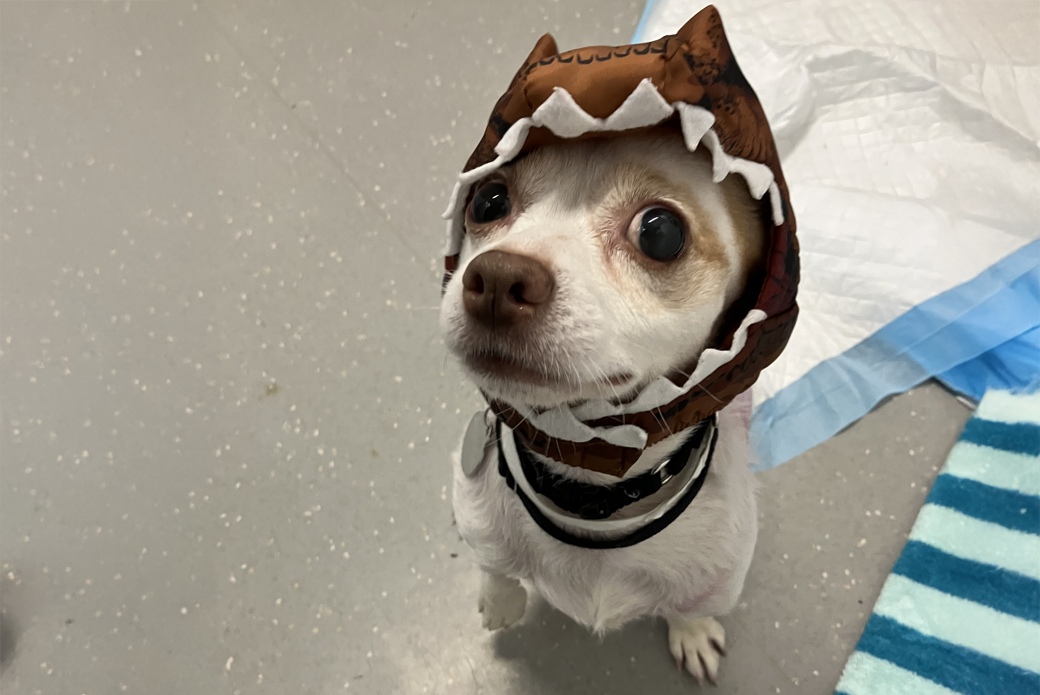
“We thought there’s no harm in calling the ASPCA; there’s no commitment for us to have the phone call,” remembered Alex. “So, Heather and I were out at lunch, and we had a phone call with a representative from the ASPCA who told us about Maeve’s backstory—which we had no idea about. It went from, ‘Oh there’s no commitment when you just have a phone call,” to immediately having our hearts melted and thinking, ‘We need to meet this girl and hopefully bring her into our lives.’”
A Painful Past
Early in August 2024, the NYPD found Maeve abandoned with severe and suspicious burns covering her back, arms, shoulders and chest. For such a small dog, these burns covered most of her body, and our teams knew she needed immediate care.
“Maeve was in a lot of pain when she came to us, so she required several days in our intensive care unit (ICU) just for pain management,” remembered Erica Barbot, director of the ASPCA Animal Recovery Center (ARC), a facility located in New York City which is dedicated to providing lifesaving veterinary care, behavioral assessments and treatments for dogs and cats, many of whom are victims of neglect or cruelty. “Her wounds were quite severe, and she was really hesitant to being handled at all because of the pain she was experiencing.”
Maeve was not only enduring severe pain from her burns but was displaying what our team refers to as “anticipatory pain.”
“She had associated handling with pain at this point because of the severity of her wounds,” said Erica. “She was giving us all the signs of saying, ‘I’m in pain, please don’t touch me. Please don’t hurt me anymore.’”
Our medical staff got to work immediately on Maeve, covering her in bandages and changing them multiple times a day to heal her wounds.
“Little by little she started to form bonds with the folks who were delivering her primary care and started to change her associations with touch from pain to more friendly associations instead,” explained Erica. “Our medical and ICU teams started being able to do more with her without her reacting so severely and without her crying out in pain. Over time her friend group grew, and she allowed more people to handle her more consistently.”

After nearly two weeks, Maeve no longer required extensive pain management and was finally cleared to be moved from our ICU to our shelter environment at ARC. Here, she was housed in Erica’s office as she needed a bigger space to settle in.
“I knew she was a sensitive girl who needed a little bit of time to make friends, so she came into my office, and I ignored her,” Erica laughed. “I let her approach me and did some baby talk. I was really happy to see that she approached me right away and nudged my hand for pets and when I’d stop, she’d continue to nudge my hand for pets. She was giving me all the signs to say that she was comfortable with me touching her and handling her. She had come such a long way already.”
Once Maeve had mostly healed from her wounds, it was determined that she wasn’t going to have much hair growth in the affected area. That skin would now need additional sun protection during walks and while in direct or indirect sunlight.
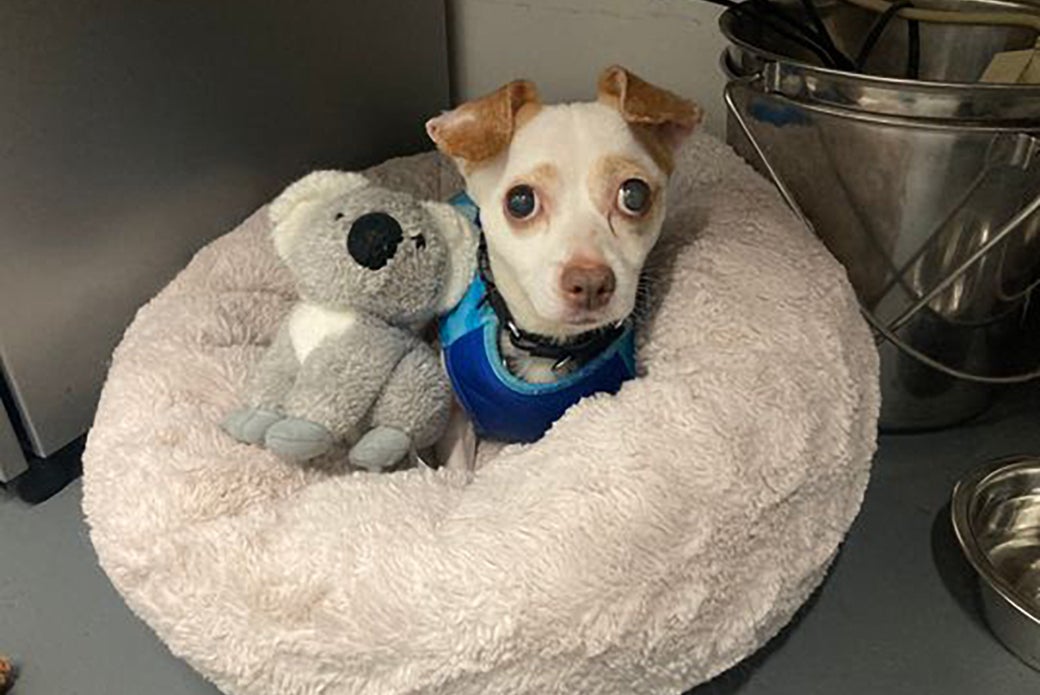

“We ordered her a UV shirt that she had to wear,” Erica told us. “She wasn’t a fan of it at first. That type of shirt is made to go over Maeve’s head and for her, that was scary.”
Wearing the shirt would now be a lifetime requirement for her skin condition, so our behavior team at ARC worked hard with Maeve to desensitize her from having the shirt put on.
“It was critical to her next step in moving to foster and then into adoption,” said Erica.

With time, patience, lots of treats and dedicated staff, Maeve became a pro at getting her shirt on, giving confidence to Erica and the rest of the ARC staff that she was ready to move into a foster home.
For Maeve, the goal of going into a foster home was to see if she could form bonds with new people and allow those people to help her with daily tasks, like putting on her UV shirt and applying ointments.
Thankfully, we found just the person to help.
A Dedicated Foster Caregiver
Carly M. has always loved dogs and being able to give back to the community, and while she’s not at the stage in her life where she can adopt a dog, she finds that fostering is the perfect solution.
“Knowing that there’s an opportunity to give a dog a temporary home and to create a loving environment so that wherever they end up next it’s an easy transition and they can go be someone else’s dog for life – it’s really rewarding and makes me want to continue fostering,” said Carly. “It brings me joy.”
 Carly M. and Maeve as they reunited at the ASPCA Adoption Center following Maeve’s adoption.
Carly M. and Maeve as they reunited at the ASPCA Adoption Center following Maeve’s adoption.
Carly came across Maeve in an ASPCA email stating that she was looking for a foster home where she could heal.
“I had read about her injuries, but it wasn’t until I came to the Adoption Center, and they let her off the leash to run around the room that I saw the extent of her burns,” remembered Carly. “But I didn’t care. For me, I just wanted to cuddle her and pick her up.”
Leaving our facilities was a big, scary change for Maeve, who sadly shook during the whole ride home. Fortunately, things began to turn around quickly.
“As soon as we got home and I let her off her lead—she still had her UV shirt on she didn’t even let me take it off—she just raced around the apartment, got into every little corner, sniffed it all out and then just jumped right up on the bed and made herself at home. She laid on her back asking for belly rubs,” Carly told us.

That day Maeve became “queen of the castle,” taking majority spot on the bed and guarding the door.
“Any sound and she’d race to the door to be on protector mode. That was interesting because it was almost as if she was the protector even though I felt like I was the one who needed to protect her. She has a very big, bold personality and isn’t fearful of anything,” said Carly.

Within just two short weeks together, Maeve once again made impressive progress and proved to be ready to find a home to call her own. Just two days after being made available for adoption Alex and Heather inquired about Maeve.
A Family of Her Own
In late October, after a few emails and a Zoom call, Alex, Heather and their resident dog, Buttercup, headed to the Adoption Center to meet Maeve.
“It was kind of like meeting a celebrity that day because we had seen her photos online and were talking about her for a couple of days,” recalled Alex. “I remember seeing her in the lobby with Carly and thinking, ‘Oh my goodness that’s her!’ It really was like a celebrity sighting.”
After a great first meeting, Alex and Heather were able to bring Maeve home that same day, where they finally introduced her to their sons who had been begging for another dog.

Many pet parents choose to change their pet’s name after adoption, but Alex and Heather decided to stick with the name Maeve.
“When we looked up the meaning, it means like fierce warrior queen, and we just thought it suited her,” said Heather.

When Maeve arrived at her new home, she fit in seamlessly, quickly showing off her big personality.
“She totally has little sister energy,” said Heather. “When she first came in our other dog was a little territorial but then very quickly Maeve was like, ‘I own the place.’ She is the queen of the castle for sure. She’s super sweet but if I’m petting Buttercup she’ll come over and growl for attention.”
Despite being the classic younger sister, Maeve and Buttercup are best friends and spend most of their days curled up on the bed sleeping. However, when it comes to eating, Maeve once again shows her bossy personality.

The couple feed both their dogs at the same time but have to feed Maeve in her crate.
“It’s the only way to ensure that Buttercup gets a full meal because Maeve will scarf down her food,” laughed Alex.
“Maeve will run over, and Buttercup will just step aside and let her have whatever Maeve wants,” adds Heather.

Not only is Maeve best friends with Buttercup, but she’s friendly with all other dogs.
“She’s very easy to take on walks because she’s so friendly with everyone that walks by,” said Alex. “Since she has to wear a covering regardless of the weather, people are always noticing and commenting on her outfits.”
To date, Maeve has nearly 30 sweaters and shirts, and special holiday outfits too!

In addition to her coverings, Alex and Heather apply doggy sunscreen to Maeve’s skin in order to keep it healthy.
When looking to adopt a dog, it never crossed the family’s minds that they would adopt a dog with medical conditions like Maeve.
“But we just adored her right away and were like, ‘Well, this is what she’s coming to the table with, and we’ll take care of her!’” Heather told us. “I can’t imagine not having her and it’s been really wonderful to see our boys really grow to love Maeve so quickly,” she adds. “They’re so sweet with her. She’s really completed our family—although now our younger son is asking for one more.”

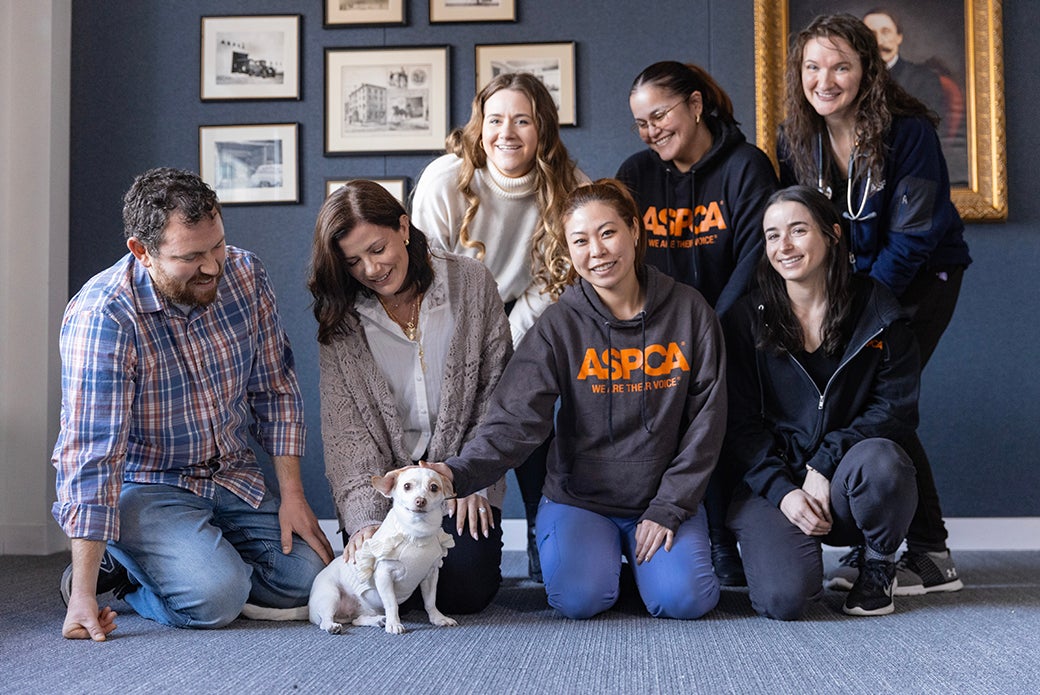

“The ASPCA has made it possible for us to bring Maeve into our lives, which has made our lives richer,” said Alex. “She’s a new presence and a new family member for us to love. It has brought a lot of joy and love into our family.”

Ginny
The victim of a dogfighting ring in the Bronx, Ginny was found scared and shivering in the cold. Every small sound and everyday experience frightened her, but with the help of the ASPCA and the love of her new family, she has been transformed.
National Relocation Program
Our team currently relocates more homeless animals than any other organization by working with overcrowded shelters in under-resourced areas of the country to relocate their animals to other shelters where they have greater chances of being adopted.

Dogfighting Rescue in South Carolina
In partnership with South Carolina authorities, the ASPCA rescued more than 150 dogs from a suspected dogfighting operation spanning 10 locations. This is one of several large-scale dogfighting cases the ASPCA has responded to in the past year, as we continue working with law enforcement to end this brutal form of cruelty.
Read more about this rescue effort

In April 2025, we partnered with the South Carolina Law Enforcement Division (SLED) to remove more than 150 dogs from 10 locations across Dillon and Marion counties. The dogs—many of whom were observed with untreated injuries and scarring consistent with dogfighting—were transferred to one of our facilities, where they received critical care.

This is just one of seven suspected dogfighting cases we have assisted law enforcement with in the past year, which also included:
- A suspected dogfighting case in March 2025 involving dozens of dogs, including puppies, removed from a property in Luzerne County, Pennsylvania.
- A suspected dogfighting case in Pinellas County, Florida, in August 2024, which resulted in the rescue of more than 100 dogs. For this case we provided subject matter expertise, legal support and conducted veterinary and behavior forensic exams on all the dogs to support the investigation.
- Assisting SLED with the execution of multiple dogfighting-related search warrants across South Carolina in 2024. In addition, we assisted dozens of investigations supported with forensic, investigative and legal support from our subject matter experts.
Over the last year, we’ve assisted nearly 350 dogfighting victims across multiple states. That’s why in honor of National Dogfighting Awareness Day on April 8, we wanted to take a moment to acknowledge the incredible dogfighting survivors we see every day, as well as our strong partnerships with local shelters and law enforcement agencies who we work alongside to protect vulnerable animals from one of the most brutal forms of abuse.

“Despite being a felony nationwide, the horrific act of dogfighting still occurs all over the country, and the ASPCA is dedicated to putting an end to this cruel suffering that impacts thousands of vulnerable animals at any given moment,” said Matt Bershadker, President & CEO of the ASPCA. “As a leading expert in dogfighting investigation and response, the ASPCA is committed to our collaborations with law enforcement and other animal welfare agencies to bring justice to its victims, provide them with the critical care they deserve, and share our learnings nationally so together we can save even more lives.”
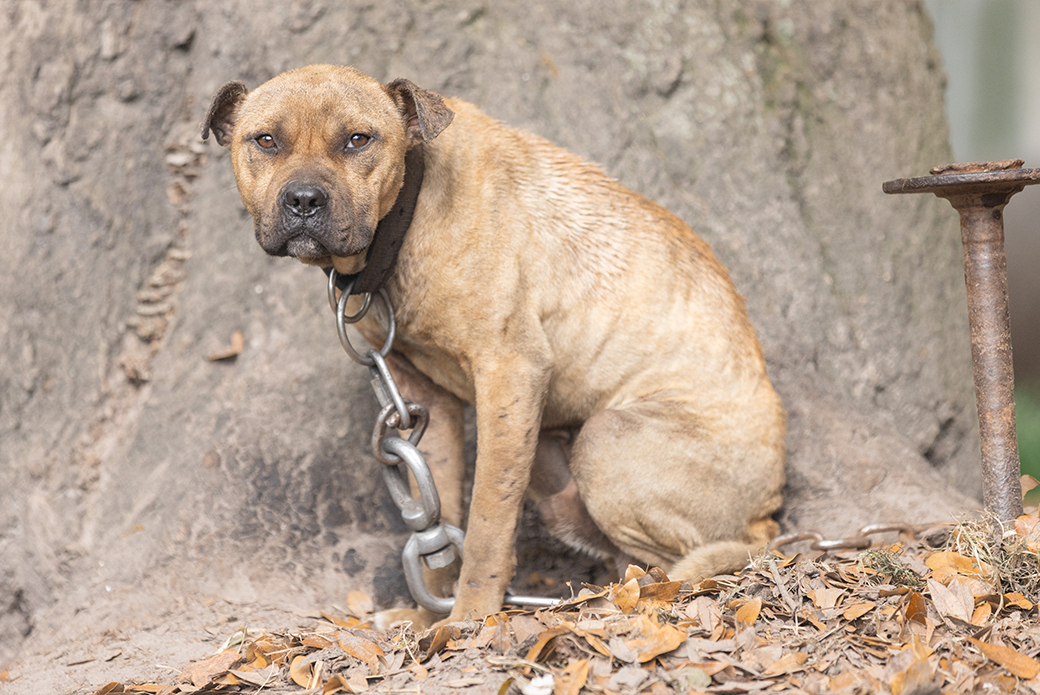
We are committed to working to bring dogfighting to an end through direct boots-on-the-ground support with seizures, subject matter consultations to assist investigations, and providing trainings for law enforcement across the country to enhance their ability to identify, investigate, respond to and prosecute dogfighting cases. In addition to our rescue and care efforts, we held a comprehensive dogfighting investigation and response workshop in North Carolina, attended by more than 50 law enforcement officers, prosecutors, veterinarians and sheltering professionals.
If you suspect that dogfighting or other animal abuse is happening in your community, please speak up. This National Dogfighting Awareness Day, we urge you to become an advocate for dogfighting victims and find out how to report animal cruelty
Horse Rescue in Montana
Nearly 90 Morgan Horses were rescued from neglect and brought into ASPCA care in one of the largest equine cruelty cases in recent years. With support from local partners, the ASPCA provided months of veterinary treatment, hoof care, behavior support and daily feeding through winter. Many of the horses from the case have found new, loving homes.
Read more about the horse rescue
 In January 2025, at the request of the Madison County Sheriff’s Office, we assisted with the extended care of nearly 90 Morgan horses who were seized as part of an investigation into alleged animal cruelty from a property in Madison County, Montana.
In January 2025, at the request of the Madison County Sheriff’s Office, we assisted with the extended care of nearly 90 Morgan horses who were seized as part of an investigation into alleged animal cruelty from a property in Madison County, Montana.
In early April, we were granted legal ownership of the horses and were finally able to begin the process of finding them loving homes.
A case like this, with close to 90 large animals in need of daily care, can present unique challenges and takes a tremendous amount of teamwork. To give our supporters an inside look into the care, time and collaboration that went into this case, we’ve asked ASPCA Equine Welfare Vice President Christie “Tex” Schulte-Kappert to tell us about her time working on this case and caring for these equines.

Q: How did the ASPCA Equine Welfare team help in this case?
A: In this case, alongside our other ASPCA teams, we provided horse care, behavior and training evaluations, and evaluated and treated medical and hoof conditions in collaboration with local providers. Because the horses affected by this case are a breed called Morgan Horses, which is a historic breed developed in the late 1700s in the United States, we collaborated with the American Morgan Horse Association (AMHA) to identify the horses during the process of helping them find good homes. We also conducted a six-day adoption event where 57 horses were adopted directly from the temporary shelter into new homes. We transported horses who needed more rehabilitation or evaluation before adoption to our ASPCA Right Horse Partner shelters/rescues, where they are getting expert, advanced care so they can be adopted soon.
Q: It’s not all that often that nearly 90 horses come into our care. Can you describe what a rescue like this looks like?
A: You’re correct! This is a bit of an unusual scenario for us because we focus a lot of our work on developing programs that help owners before horses ever get to a point of cruelty and neglect. For example, we have a program in Oklahoma where any horse owner can access subsidized veterinary care or safe rehoming, in an effort to give horse owners a judgement-free place to turn if they hit hard times. Many of our ASPCA Right Horse Partners offer similar programs nationwide, and we have supported many of these programs with grant funding over many years.
In this case, we were luckily able to temporarily shelter the horses at the ranch where they were already located, which meant we didn’t have to move them right away. We brought in tons of hay and feed and made sure they had clean water around the clock—a big job in the negative temperatures. We reinforced pens and fences so they had safe enclosures, and for horses in small areas, we made sure they got turnout and exercise. We also made sure they weren’t too crowded and were housed in groups so they could socialize happily. Most importantly, we had them all seen by veterinarians and farriers for long-overdue care.
Q: Can you describe the condition the horses came to us in? Were any medically compromised or in need of help behaviorally?
A: By the time we started caring for the horses, the Humane Society of Western Montana (HSWM) and Madison County Sheriff’s Office (MCSO) had provided good quality hay for a few months, so many had gotten back up to a healthy weight. Many of the horses had untreated medical conditions like metabolic diseases and various lamenesses (injuries or other conditions in their legs and/or hooves that can be painful and debilitating). One mare had an eye injury which we treated, and another had a painful tooth/sinus abscess. Several horses showed signs of laminitis, which is a very painful condition that affects the hooves and can easily become serious or chronic. Many of the horses had not had good hoof care for a long time, so they were suffering from long toes, poor hoof angles and other hoof problems that made standing and walking painful and can impact their long-term health and soundness. For large prey and herd animals like horses, these conditions can be extraordinarily painful, debilitating and even life-threatening.
Behaviorally, many horses were fearful and hard to catch, which made basic care difficult. It appeared some had not been handled in a long time, and many of the young horses appeared to have never had basic halter training.
Q: What does rehabilitation look like for these horses?
A: After the basics of enough quality hay/feed and water, the horses all needed veterinary care. Veterinarians examined each horse individually to identify issues and create a treatment plan (such as for the metabolic disease, laminitis and lameness), and vaccinated each horse. Farrier care was also a huge part of their rehab, as it can take months or longer to correct issues as the hoof regrows. The farriers examined each horse individually as well, and we took detailed notes about their initial status and the ongoing plan. For horses with more complex hoof issues, we took radiographs (X-rays) so that the farriers could see the underlying bones of the hoof and trim and shape the foot accordingly.
Q: Beyond rehabilitation, housing and caring for this many horses is a feat in and of itself. Can you explain what daily care has looked like and how many people are needed to get these animals the care they need?
A: We had a team of 6-12 dedicated staff on the ground every day from mid-January through the end of April taking care of the horses’ daily needs and bringing them back to health. We also coordinated with two local veterinarians and three local farriers, who provided excellent care. Especially in the winter, keeping water thawed was a full-time job! We ran several generators and broke ice so that each horse had access to clean water in sub-zero temperatures. We also fed extra hay to help horses stay warm in the cold weather. And every day, we gave medications to horses who needed them and treated any ongoing injuries or conditions. This case was unique in part because of the sheer size of the herd, so daily care was a massive undertaking, but one that our teams were prepared for.
Q: Are there still horses in our care? If so, why, and what care are we providing them?
A: EVERY horse from the case has been placed! Over 60 in total were ready for adoption right away after we gained custody, thanks to the hard work our teams had put in for the four months we cared for them at the temporary shelter. These lucky horses were adopted directly into new, loving homes in mid-late April, and we’re already hearing happy updates from their adopters as they settle in. Others went to ASPCA Right Horse Adoption Partners for further rehabilitation so they can be adopted soon. We are also collaborating closely with the AMHA to identify the horses via DNA test, register them with the breed registry whenever possible, and provide their new owners with those registration papers, which are an important link to their identity and history.
Q: Why is the work we’re doing with these horses, and our equine work in general, important?
A: While it may not be as common to own a horse as a dog or cat, they need just as much care and protection as small animals. Horses can become at-risk for many reasons, and our equine welfare work is focused on preventing horses from falling into bad situations whenever possible and helping them get to new, loving homes as quickly as possible. This case is a strong example of how vulnerable horses are, and how much work it takes to get them healthy again and ready for new homes. It takes a lot of knowledge and dedication from many different people to help a group of horses this size; we have the unique ability to take on such a large case.


New Animal Support Center in Mississippi
In partnership with Oktibbeha County Humane Society, the ASPCA opened the OCHS Animal Support Center in Starkville. The facility includes a spay and neuter clinic and the VanLandingham Kennel Facility, which will support thousands of animals each year through preventive care and relocation. This new center expands the region’s ability to care for shelter animals and help them find safe, loving homes.
Read about the Animal Support Center
On April 8, in collaboration with Oktibbeha County Humane Society (OCHS), we announced the opening of the OCHS Animal Support Center by the ASPCA, a first-of-its-kind facility in Mississippi that will bring animal sheltering and veterinary care services to thousands of vulnerable animals in the state each year. The Animal Support Center will house the OCHS Spay & Neuter Clinic, a stationary spay/neuter clinic for pet owners and shelter animals, and the VanLandingham Kennel Facility, a hub for the region’s shelter animals where they will be provided temporary care in preparation for relocation to other shelters for adoption.
“The opening of the OCHS Animal Support Center marks the beginning of a new era of expanded animal welfare services for dogs and cats in Northeast Mississippi,” says Matt Bershadker, ASPCA president and CEO. “The ASPCA® is incredibly proud to have partnered with OCHS over the past eight years with a shared goal of creating a better future for animals across the region, and this new center is a monumental step forward in creating that better future for vulnerable animals.”
The Animal Support Center, which was built in part through $1 million in grant funding from the ASPCA, will help increase and improve OCHS’s capacity to care for animals in Starkville and the shelter’s 17-county service area. The Animal Support Center’s high-quality, high-volume spay/neuter and relocation efforts will impact thousands of animals in the state by reducing the number of unwanted litters within the community, decreasing animals’ length of stay at shelters in the region, and improving access to low-cost spay and neuter procedures for pet owners. The new Spay & Neuter Clinic will increase the shelter’s current spay/neuter capacity from 2,900 to 5,800 surgeries annually.

The opening of the Animal Support Center’s VanLandingham Kennel Facility marks an especially important extension to the OCHS campus. Resulting in roughly 3,300 square feet of additional space, including 30 new kennels, the VanLandingham Kennel Facility provides a separate holding area for animals being transported to other shelters for adoption, improving health safeguards for both shelter and transport populations. A covered space with a weatherized loading and unloading area will accommodate larger numbers of animals at one time, enabling transports to happen more efficiently.
Through the VanLandingham Kennel Facility, OCHS will be able to increase the number of animals they can send on transports annually from 1,800 to 3,500. With shelter animals in Mississippi experiencing increased lengths of stay due to ongoing capacity challenges and strained resources, the VanLandingham Kennel Facility will help displaced and vulnerable dogs and cats move to shelters with the space and resources to provide the care they need until they are adopted.

“Over the next few years, we hope to see the OCHS Animal Support Center by the ASPCA serve as a catalyst for positive change in animal welfare in the region, enabling OCHS to not only support more animals, but serve as a resource for pets and their people,” says Michele Anderson, executive director of Oktibbeha County Humane Society. “With increased transport capacity and expanded spay/neuter services, we expect to see more positive outcomes for animals in the region. Through this new facility, OCHS and our partners will show what’s possible when we come together to tackle animal welfare challenges head-on.”
Over the last eight years, the ASPCA and OCHS have worked together to improve the lives of shelter animals in the Starkville, Mississippi, area and surrounding communities. OCHS is a partner shelter in the ASPCA Animal Relocation Program, an initiative that works with overcrowded shelters in under-resourced areas of the country to relocate their animals to other shelters where those animals have greater chances of being adopted into loving homes. Since 2016, OCHS has partnered with us to move over 18,000 animals from OCHS to shelters with more opportunities for adoption.

Wildfire Response in Los Angeles
Following the Eaton and Palisades Fires in January 2025, the ASPCA was on the ground in Southern California assisting nearly 4,000 animals through rescue operations, sheltering and veterinary care. Working alongside Pasadena Humane and other partners, our team has supported lost pet reunifications, provided field response expertise and distributed critical supplies.
Read more about the wildfire response
In January 2025, the ASPCA disaster response team was on the ground in Southern California at the request of Pasadena Humane, Los Angeles County, and Los Angeles City officials assisting nearly 4,000 animals in the aftermath of the devastating Eaton and Palisades Fires.
Alongside local and national partners including the International Fund for Animal Welfare (IFAW), American Humane Society (AHS), San Diego Humane Society, the San Diego Department of Animal Services, and the North Valley Animal Disaster Group, we assisted with immediate animal needs through search and rescue, feeding-in-place operations and sheltering support. The ASPCA’s disaster response team responded to more than 520 service calls from community members requiring assistance with lost and found pets, emergency veterinary care, pet supply needs and more.
“Providing vulnerable animals, pet owners, and shelters with lifesaving assistance in the aftermath of the devastating wildfires in Los Angeles has been a collaborative effort, and the ASPCA is dedicated to working with our local and national partners to continue providing critical rescue, care, and shelter support for as many animals as we can,” said Matt Bershadker, ASPCA President and CEO. “The ASPCA immediately mobilized to assist ongoing relief efforts, and we are immensely grateful to work alongside the many disaster response partners who have stepped up to ensure the safety of displaced animals and help impacted families care for their beloved pets.”
Ongoing Response Efforts
Highly trained ASPCA disaster response personnel assisted Pasadena Humane with daily shelter support and field operations including animal search and rescue in collaboration with Los Angeles County Animal Care & Control. We also supported animal reunification efforts, providing disaster management guidance and assisting with pet supply distribution and other critical aid. These efforts have supported needs stemming from the Eaton Fire, which decimated areas of Pasadena, Altadena and surrounding communities after setting ablaze the evening of January 7.
At the request of Los Angeles Animal Services (LAAS), the ASPCA has also facilitated animal search and rescue in areas devastated by the Palisades Fire in the Pacific Palisades neighborhood of the city. National Animal Rescue & Sheltering Coalition (NARSC) partners IFAW and American Humane Rescue, a program of AHS, are on the ground at the request of the ASPCA, supporting this vital work and assisting with planning and coordination, animal search and rescue, feed-in-place operations as well as pet reunifications in the field and at local shelters.
Through collaboration with LAAS and the office of Los Angeles Mayor Karen Bass, the ASPCA has helped enhance field rescue operations in impacted communities to maximize the number of animals rescued and reunited with their owners. In addition, our Los Angeles-based Community Medicine team provided LAAS with veterinary support to help local shelters prepare animals for adoption, foster, and relocation by assisting with vaccinations, health certifications, and spay/neuter.


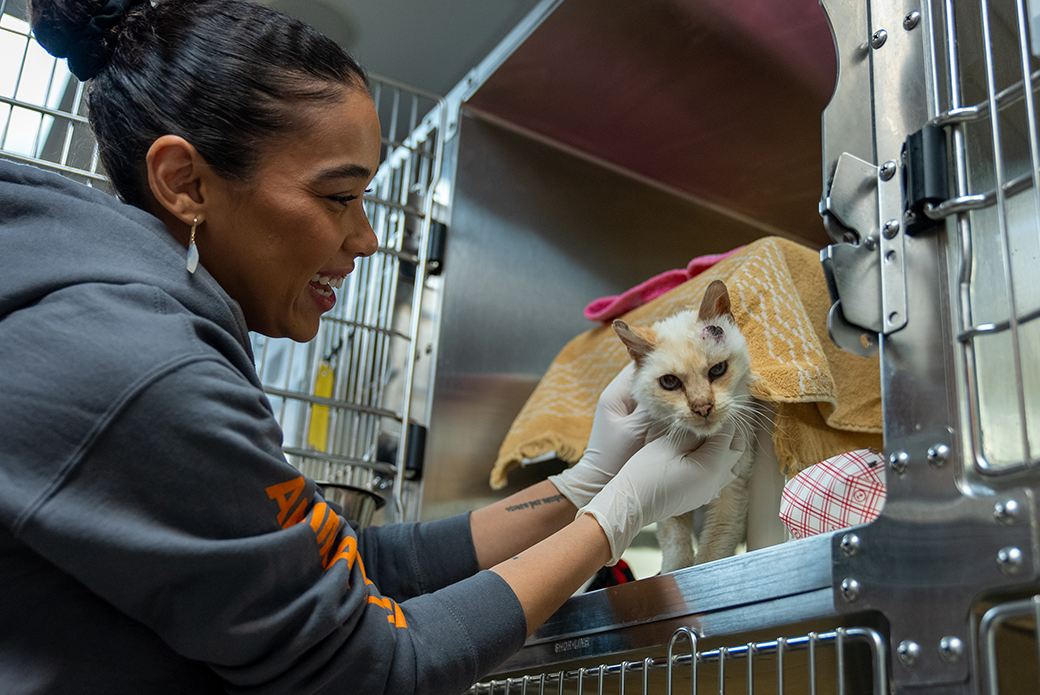
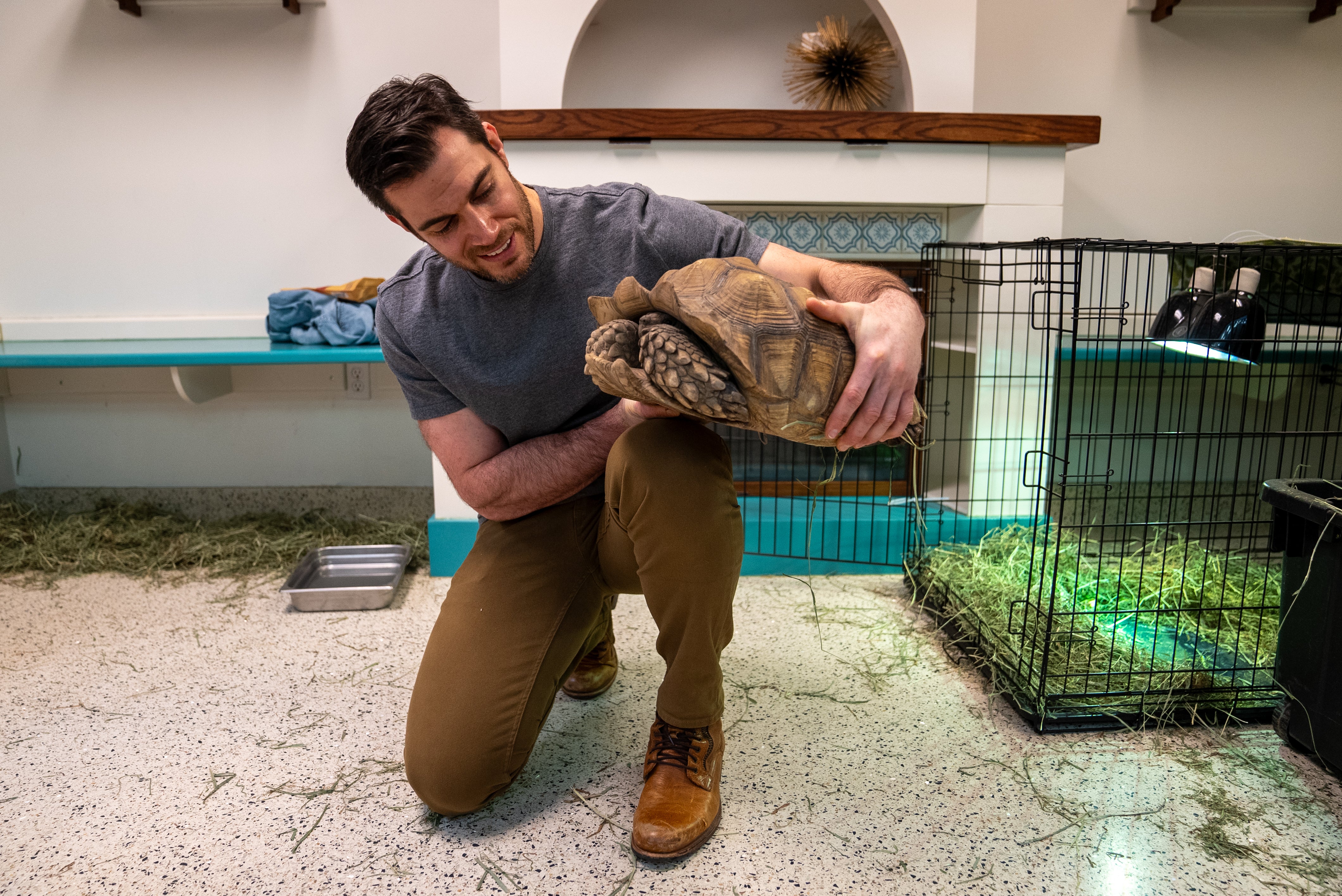


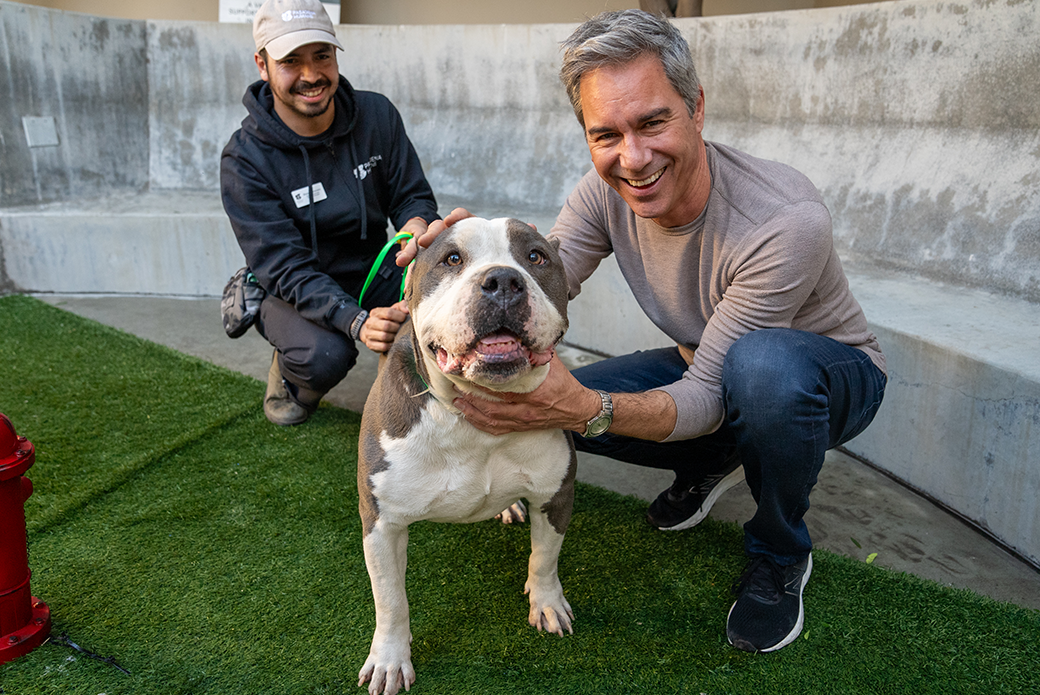

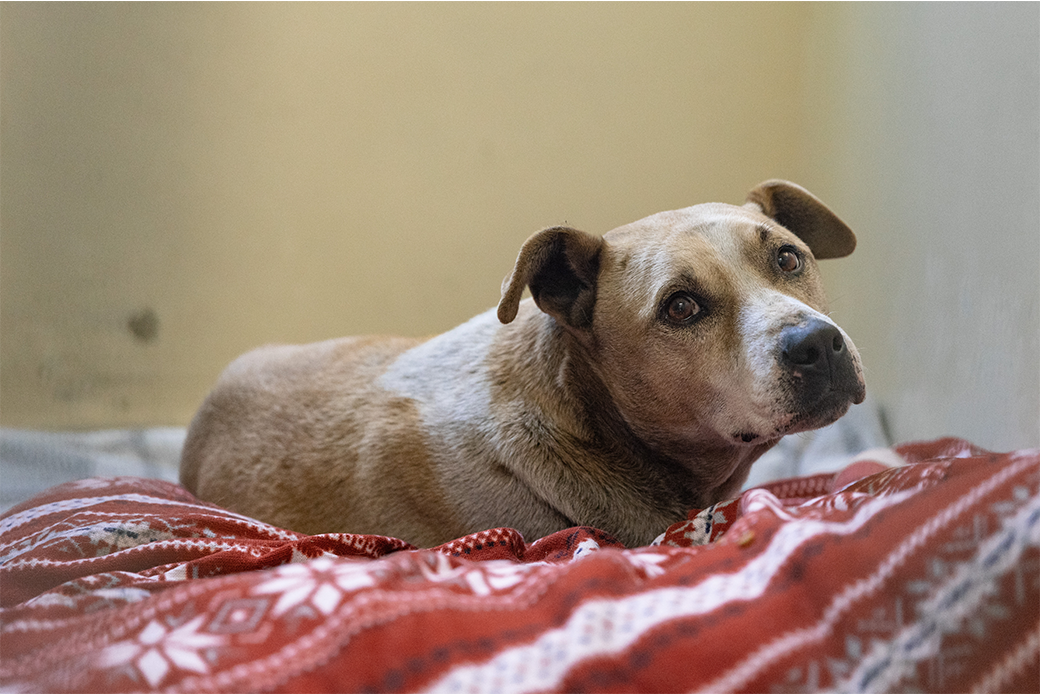
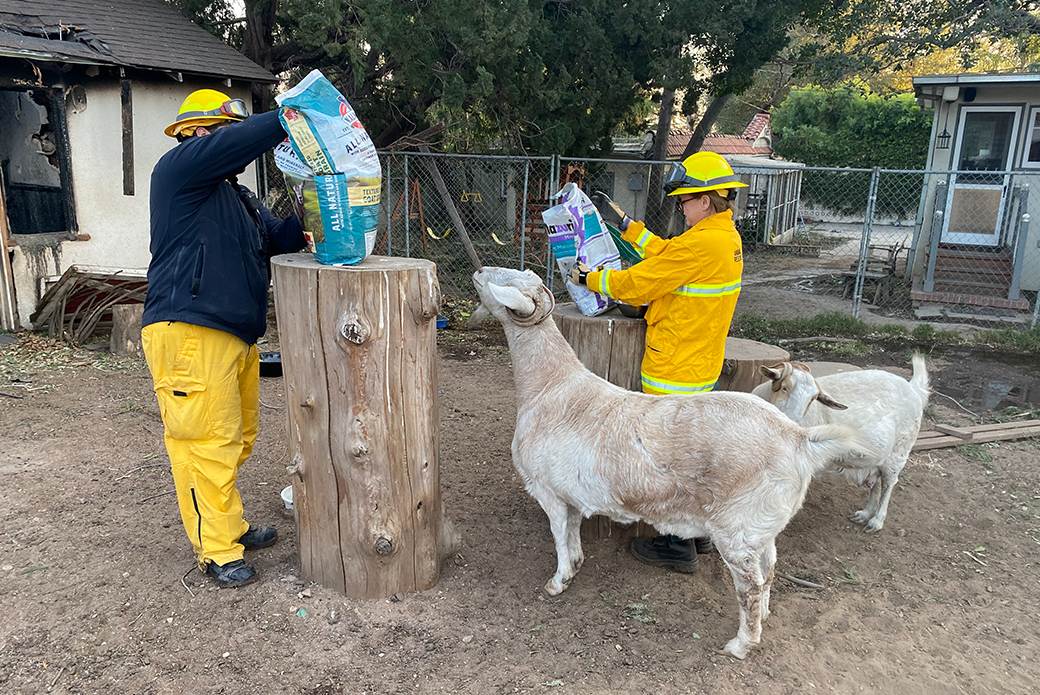
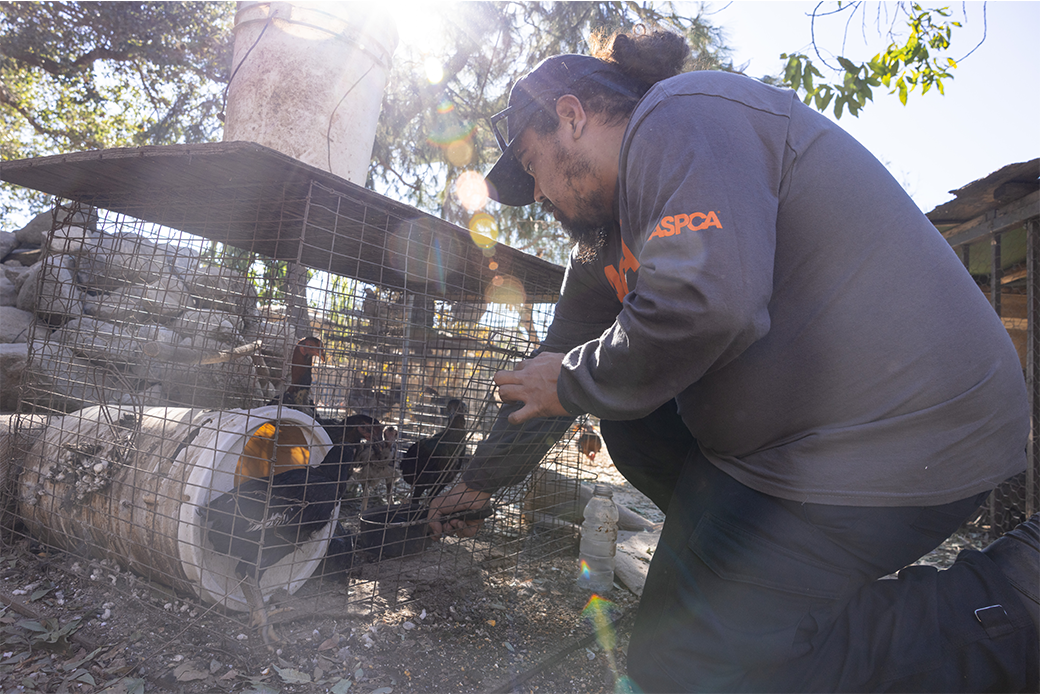
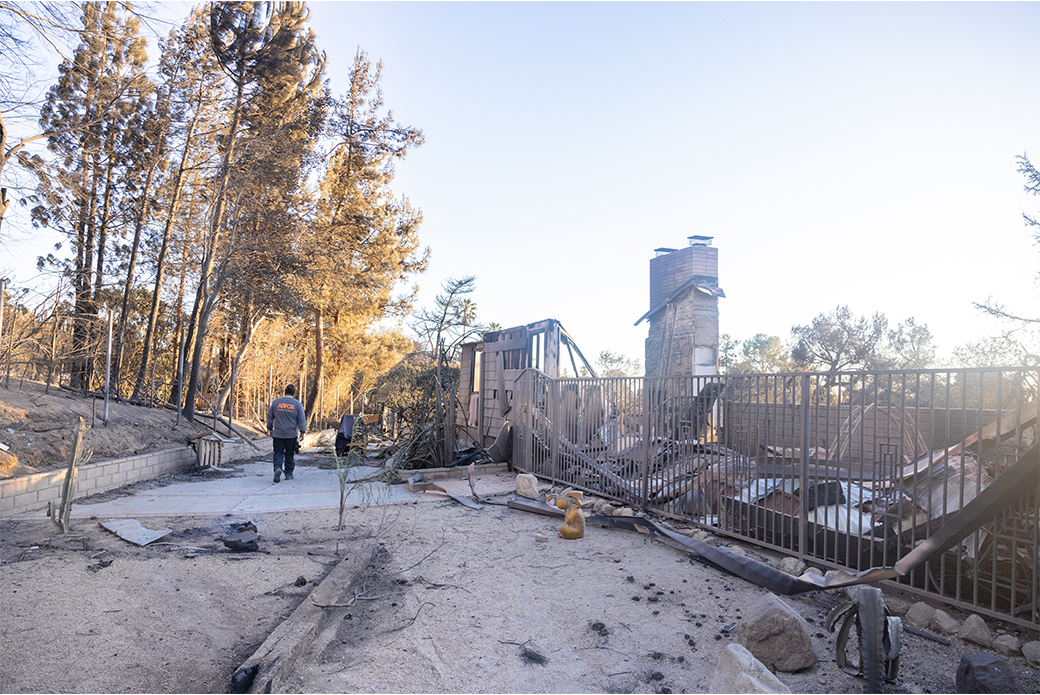





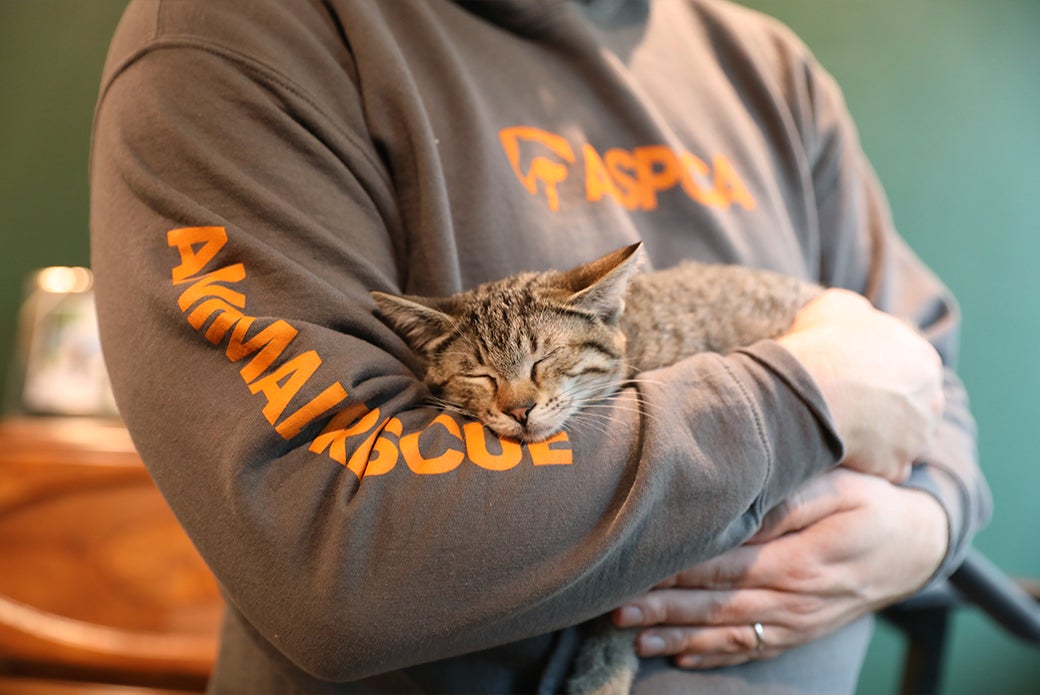


Easy Ways to Make a Major Impact

Gifts that cost you nothing now


Gifts that reduce your taxes


Gifts that provide payments for life


Gifts that make an impact now

Your Giving Toolkit
Need assistance? We're here to help!

Nicole Nahas
Sr. Director, Planned Giving & Donor Stewardship
